The world of drone technology is rapidly evolving, and with it, the need for effective training methods. As Elon Musk once said, “When something’s important enough, you do it even if the odds are against you.” This quote resonates with the importance of innovative technologies like the VR FPV simulator in the drone industry.
We’re on the cusp of a revolution in pilot training, where drone VR simulators are transforming the way pilots develop their skills. By providing a safe and controlled environment, these simulators enable pilots to hone their flying skills without risking expensive equipment.
These advanced simulation tools not only enhance training efficiency but also eliminate the risks associated with training new pilots on actual drones. As a result, pilots can practice in various virtual scenarios that mimic real-world conditions, becoming more skilled and confident in the process.
Key Takeaways
- Drone VR simulators revolutionize pilot training by providing a safe and controlled environment.
- Advanced simulation tools enhance training efficiency by up to 50%.
- VR simulators eliminate risks associated with training new pilots on actual drones.
- Cost-effective solutions for individual pilots and training institutions.
- Leading drone VR simulators offer key features that improve pilot skills.
Understanding Drone VR Simulators
Drone VR simulators are revolutionizing the way pilots train, offering an immersive FPV experience that enhances skill development. These advanced tools are designed to provide a realistic and engaging way for pilots to hone their skills without the risk of damaging actual drones.
What Are Drone VR Simulators?
Drone VR simulators are sophisticated software programs that mimic the flight experience of drones, allowing pilots to practice and improve their flying skills in a virtual environment. The SRIZFLY Drone Simulator is a cutting-edge tool that provides an immersive FPV experience for drone pilots, featuring advanced graphics and realistic flight physics.
The Evolution of Drone Training Technology
The journey of drone training technology began with basic flight simulators that offered limited graphics and simplified physics models. Over time, advancements in computing power led to the development of more sophisticated simulation software that could accurately model drone flight characteristics and environmental conditions.
- The integration of virtual reality marked a significant step forward, transforming flat-screen experiences into fully immersive training environments.
- Modern drone VR simulators now incorporate haptic feedback controllers, providing physical sensations that mimic the resistance and response of actual drone controls.
- The latest generation of training platforms features AI-driven scenarios that adapt to the pilot’s skill level, creating personalized learning experiences.
This evolution has made drone simulator training more effective and accessible, revolutionizing the way pilots learn and improve their skills.
Benefits of Using Drone VR Simulators
Drone VR simulators are revolutionizing the way pilots train, offering a more efficient, safe, and cost-effective solution. By providing a realistic and immersive training environment, these simulators address several challenges faced by traditional training methods.
Enhanced Training Efficiency
The use of drone VR simulators significantly enhances training efficiency. Training programs can be tailored to individual needs, allowing pilots to practice and improve their skills in a controlled environment. This personalized approach reduces the time required to achieve proficiency.
Improved Safety Measures
Safety is a paramount concern in drone training. Drone VR simulators provide a safe platform for pilots to learn and make mistakes without risking damage to equipment or posing a danger to others. This virtual environment helps in developing the skills and instincts necessary for safe drone operation.
Cost-Effectiveness for Training Programs
Implementing drone VR simulators in training programs can lead to significant cost savings. The benefits include:
- Reducing equipment repair and replacement costs by up to 80%.
- Saving on battery purchases and maintenance.
- Optimizing investment in equipment while maximizing training capacity.
- Eliminating travel expenses to suitable flying locations.
The SRIZFLY Drone Simulator, with its competitive pricing and subscription options, is an affordable solution fordrone pilotsand organizations.
Key Features to Look for in a Drone VR Simulator
When selecting a drone VR simulator, several key features must be considered to ensure an effective training experience. The ideal simulator should offer a combination of realistic flight physics, advanced graphics, and compatibility with a range of controllers.
Realistic Flight Physics
A simulator with realistic flight physics is crucial for effective training. It allows pilots to experience the actual handling characteristics of their drone, making the training more relevant and useful. SRIZFLY Drone Simulator, for example, is known for its accurate flight dynamics.
Advanced Graphics and Rendering
Advanced graphics and rendering capabilities are also vital. They provide a more immersive experience, making it easier for pilots to become fully engaged in the training scenario. High-quality visuals help in simulating real-world conditions more accurately.
Compatibility with Controllers
The best drone VR simulators offer compatibility with a wide range of physical controllers, allowing pilots to train with the same equipment they’ll use in real-world flights. For instance, SRIZFLY Drone Simulator is compatible with DJI FPV Remote Controller 2 and DJI Motion Controller, making it an ideal choice for DJI pilots. Key considerations include:
- Support for popular radio controllers from manufacturers like DJI, Futaba, Spektrum, and FrSky.
- The ability to customize controller mapping and sensitivity adjustments.
- Support for specialized FPV controllers and motion controllers.
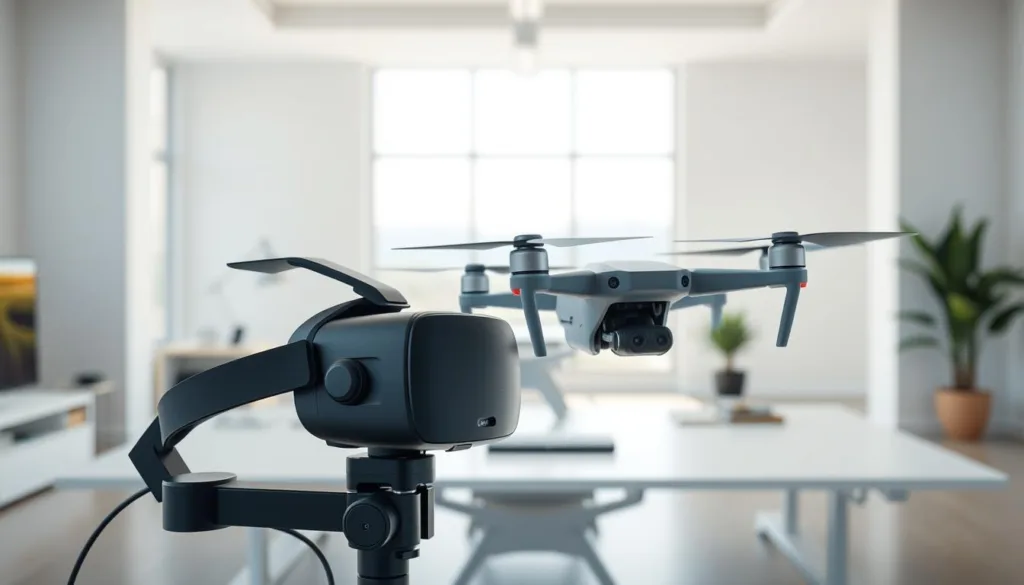
SRIZFLY Drone VR Simulator

SRIZFLY Drone VR Simulator is revolutionizing drone training with its realistic simulations. This advanced tool is designed to provide an immersive experience for drone pilots, enhancing their skills in a safe and controlled environment.
Overview and Specifications
The SRIZFLY Drone VR Simulator boasts impressive specifications, including realistic flight physics and advanced graphics rendering. This simulator is designed to mimic real-world drone flight, providing pilots with a truly immersive experience. With its cutting-edge technology, the SRIZFLY Drone VR Simulator is an ideal tool for FPV drone enthusiasts and professionals alike.
Training Modules and Scenarios
The SRIZFLY Drone VR Simulator offers a range of training modules and scenarios, catering to different skill levels and training needs. Pilots can practice FPV drone flying in various environments, from simple to complex scenarios, enhancing their skills and confidence. The simulator includes a variety of customizable training scenarios, allowing users to tailor their training to specific needs.
Pricing and Subscription Options
SRIZFLY Drone Simulator offers flexible pricing and subscription options to accommodate different needs and budgets. Users can choose from a one-time purchase or subscription plans, with options including:
- Basic subscription: Access to essential training modules and drone models at an affordable monthly rate.
- Professional subscriptions: Advanced features, customizable training scenarios, and detailed performance analytics.
- Enterprise licensing: Bulk discounts, administrative controls, and custom scenario development.
All subscription tiers include regular software updates, ensuring users benefit from the latest improvements in physics modeling, graphics rendering, and new drone model additions.
DJI Flight Simulator

DJI Flight Simulator is a powerful tool for drone pilots to hone their skills in a realistic and safe environment. The simulator is designed to provide a comprehensive training platform that enhances flight skills and prepares pilots for real-world challenges.
Features and Compatibility
The DJI Flight Simulator boasts a range of features that make it an ideal choice for drone pilots. These include:
- A clean, user-friendly interface that mirrors the DJI Fly and DJI GO4 apps, creating a familiar environment for pilots already using DJI products.
- Excellent performance optimization, running smoothly on mid-range computer systems without requiring high-end gaming hardware.
- Realistic rendering of DJI’s camera systems, allowing pilots to practice photography and videography techniques alongside flight skills.
User Experience and Performance
The DJI Flight Simulator delivers a seamless user experience, with detailed flight telemetry and performance metrics that match what pilots see on their actual controller displays. This reinforces the connection between simulation and real-world flying, enabling pilots to refine their skills effectively. Additionally, DJI regularly updates the simulator to maintain compatibility with their latest drone models and controller firmware, ensuring the training experience remains relevant and accurate.
Liftoff: FPV Drone Racing Simulator
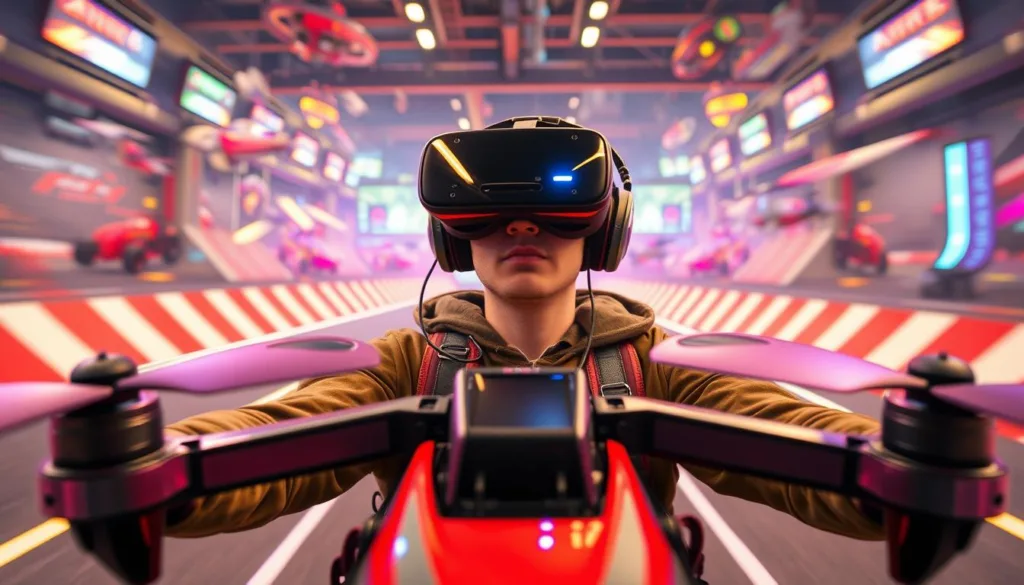
Liftoff: FPV Drone Racing Simulator is revolutionizing the world of drone racing with its realistic graphics and immersive experience. This simulator is designed to provide drone enthusiasts with a realistic and engaging platform for racing and training.
Racing Features and Physics
The Liftoff simulator boasts advanced racing features and realistic flight physics, making it an ideal choice for FPV drone racing enthusiasts. With its realistic graphics and immersive experience, pilots can hone their skills and prepare for various racing scenarios. The simulator’s physics engine ensures a realistic flying experience, allowing pilots to practice and improve their flying techniques.
Community and Multiplayer Options
Liftoff features a robust multiplayer system that connects racing pilots worldwide, enabling competitive practice sessions and organized racing events. The simulator’s integrated leaderboard system tracks lap times and race results, fostering healthy competition among pilots. Additionally, the platform supports spectator modes for race viewing, allowing coaches and teammates to observe flights from multiple angles and provide technical feedback.
The thriving community around Liftoff includes pilots sharing custom tracks, drone configurations, and training methodologies through the platform’s workshop feature. Regular community events and virtual racing leagues provide structured competitive opportunities, helping pilots develop the mental focus and pressure management needed for actual race day performance.
VelociDrone FPV Racing Simulator
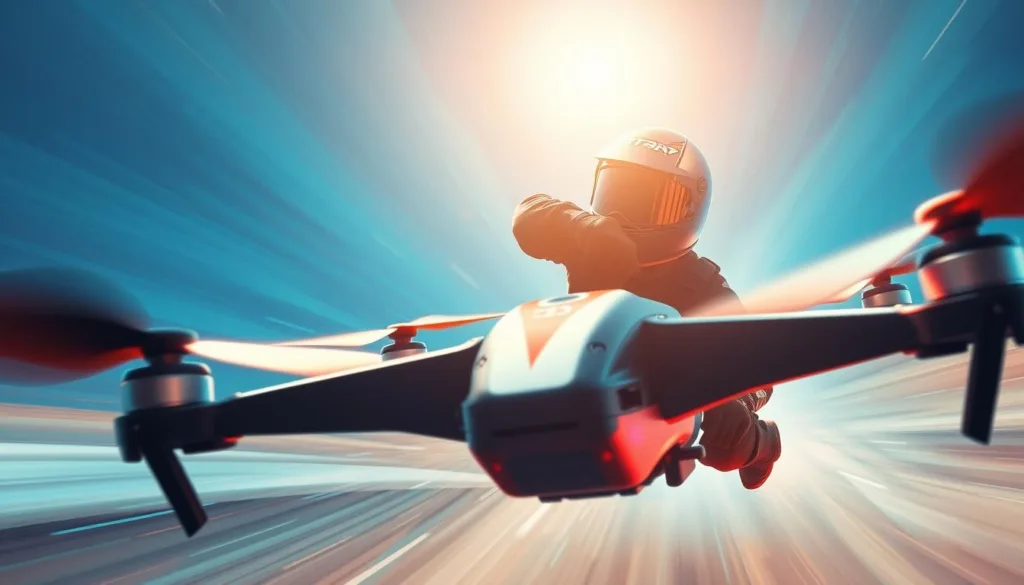
VelociDrone FPV Racing Simulator is revolutionizing the world of drone racing with its advanced features and realistic simulations. As a leading FPV drone simulator, it offers a comprehensive platform for both amateur and professional drone racers to improve their skills.
Performance and Track Options
VelociDrone stands out with its diverse range of tracks and performance options, catering to various skill levels and preferences. The simulator offers realistic flight physics and a variety of racing modes, ensuring an immersive experience. Key features include:
- Multiple track options with varying complexity
- Realistic flight physics for an authentic racing experience
- Support for a wide range of controller configurations
Professional Training Capabilities
VelociDrone has been adopted by professional drone racing leagues and teams as their primary training platform, validating its effectiveness for competitive preparation. The FPV simulator offers specialized training modules focused on specific racing skills, such as hairpin turns and precision gate navigation, with detailed performance feedback.
- Specialized training modules for specific racing skills
- Progressive difficulty system for optimal learning
- Race replay system for analyzing performance
Industry Applications of Drone VR Simulators
Drone VR simulators are transforming industries by providing pilots with the skills needed for complex operations. By utilizing a VR FPV simulator like SRIZFLY, pilots can improve their skills across various parameters such as precise control and aerial maneuvers without the limitations of real-world conditions, ultimately enhancing their experience with a drone racing simulator.
Agriculture and Inspection
In agriculture, drone VR simulators are used to train pilots for crop monitoring, field inspection, and precision agriculture. Simulators provide realistic scenarios for pilots to practice navigating through fields, identifying crop health issues, and operating in various weather conditions. This training enhances the efficiency and accuracy of agricultural drone operations.
Security and Surveillance
For security and surveillance, drone VR simulators train pilots to conduct aerial surveillance, monitor critical infrastructure, and respond to emergency situations. The simulators offer scenarios that mimic real-world security challenges, allowing pilots to develop the necessary skills for effective surveillance and response.
Logistics and Delivery
Logistics companies are leveraging drone VR simulators to train delivery pilots. The simulators provide training in navigating urban environments, identifying suitable landing zones, and managing package deployment mechanisms. Specialized delivery simulation modules include practice in route optimization, obstacle avoidance, and handling various weather conditions.
| Industry | Application | Simulator Benefits |
|---|---|---|
| Agriculture | Crop Monitoring, Field Inspection | Enhanced Efficiency, Accuracy |
| Security | Aerial Surveillance, Emergency Response | Improved Response Times, Situational Awareness |
| Logistics | Delivery Operations, Route Optimization | Reduced Costs, Increased Safety |
Hardware Requirements for Optimal VR Drone Simulation
A seamless drone VR simulation experience relies heavily on the quality of your hardware. To ensure an immersive and effective training environment, it’s essential to understand the key hardware components required.
Computer Specifications
For a drone VR simulator to function optimally, a powerful computer is necessary. We recommend a system with a multi-core processor, such as an Intel Core i7 or AMD Ryzen 9, to handle complex graphics and physics calculations. In addition, a high-performance graphics card, like an NVIDIA GeForce RTX 3070 or AMD Radeon RX 6800 XT, is crucial for rendering high-quality visuals and ensuring smooth flight simulations. Adequate RAM, at least 16 GB, is also vital for maintaining a stable and responsive simulation environment.
VR Headsets and Controllers
The choice of VR headset significantly impacts the quality of drone simulation training. Higher resolution displays provide the visual clarity needed for distance judgment and precise maneuvering. We recommend headsets with a minimum resolution of 1440×1600 per eye and a refresh rate of 90Hz or higher to prevent motion sickness during rapid drone movements. Wide field-of-view headsets (100° or greater) provide peripheral vision awareness that’s crucial for realistic flight experience. For the most immersive experience, a complete setup includes the VR headset, drone controller integration, and a powerful computer system working in concert.
Controller selection is equally important, with the ideal setup allowing pilots to use their actual drone controllers connected to the simulation system for perfect training transfer, making it an ideal solution for drone training. By choosing the right hardware, you can create a user-friendly interface that enhances your drone VR simulation experience.
How to Choose the Right Drone VR Simulator for Your Needs
Selecting the ideal drone VR simulator is crucial for effective training and enhanced flying skills. With various options available, the choice depends on your specific needs and goals.
For Beginners
For those new to drone flying, a simulator with realistic flight physics and user-friendly controls is essential. Look for simulators that offer training modes and tutorials to get started with basic maneuvers and safety practices.
For Professional Pilots
Professional pilots require advanced features such as customizable scenarios and high-fidelity graphics. Simulators that offer complex mission simulations and real-world environment replication are ideal for honing advanced skills.
For Drone Racing Enthusiasts
For FPV drone racing enthusiasts, simulators with ultra-responsive controls and minimal input latency are critical. Key features to look for include:
- Accurate modeling of racing-specific maneuvers like power loops and split-S turns.
- Robust multiplayer capabilities to practice with other racers.
- Customizable drone builds to mirror actual racing configurations.
- Accurate rendering of standard racing gates and timing systems.
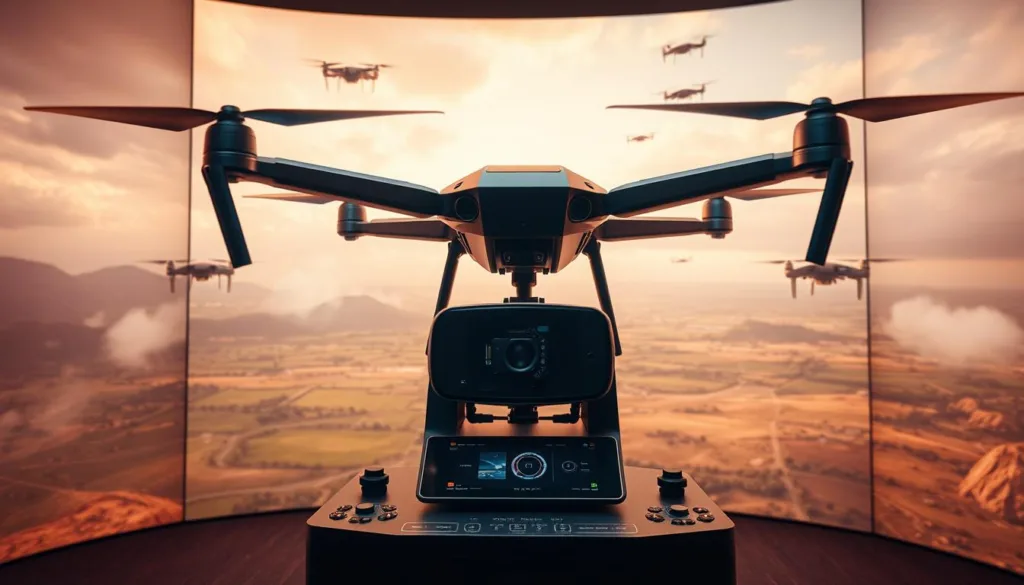
By considering these factors, you can choose a drone VR simulator that meets your needs and helps you develop skills effectively.
Setting Up Your First Drone VR Simulator
To get started with your drone VR simulator, follow these essential steps for a seamless setup. This process ensures that you can maximize the benefits of your simulator for effective drone training.
Installation Process
The installation of your drone VR simulator is the first step towards creating a realistic and immersive training environment. Ensure that your computer meets the necessary specifications for smooth performance. Download and install the simulator software from the official source, following the provided instructions carefully.
Configuring Controls and Settings
Proper configuration is critical for an effective training experience. Start by mapping your simulator controls to match your actual drone controller layout exactly. This step is crucial for developing muscle memory that transfers directly to actual flights.
- Begin with default sensitivity settings and adjust rates and expo values to match the feel of your real drone.
- Configure graphics settings based on your computer’s capabilities, prioritizing frame rate for smooth performance.
- Take advantage of camera view options to set up your preferred FPV perspective, ensuring consistency with your actual drone’s camera or FPV goggles.
| Setting | Description | Recommendation |
|---|---|---|
| Control Mapping | Map simulator controls to match your drone controller | Exact layout matching |
| Sensitivity Settings | Adjust sensitivity to match your drone’s feel | Start with defaults, then adjust |
| Graphics Settings | Balance visual quality and performance | Prioritize frame rate |
Future Trends in Drone VR Simulation Technology
The future of drone VR simulation technology is rapidly evolving, driven by advancements in AI, graphics, and physics. As we move forward, we can expect significant improvements in the realism and effectiveness of drone training simulators.
AI and Machine Learning Integration
The integration of AI and machine learning into drone VR simulators will revolutionize the training experience. AI-powered adaptive difficulty will adjust to a pilot’s skill level, providing a more challenging and realistic experience. Machine learning algorithms will also enable the simulation of complex scenarios, such as varying weather conditions and unexpected obstacles.
Enhanced Realism and Physics
Advances in physics processing will enable real-time simulation of complex interactions between drones and their environment. This includes prop wash effects on nearby objects and surfaces, creating a more immersive experience for pilots. Next-generation graphics engines will deliver photorealistic rendering with dynamic lighting and atmospheric effects, perfectly mimicking real-world visual conditions.
| Feature | Description | Benefit |
|---|---|---|
| Computational Fluid Dynamics (CFD) | Models airflow around drone components with high accuracy | Truly realistic flight behavior |
| Haptic Feedback | Provides nuanced physical sensations through controllers | Pilots can “feel” wind resistance and motor vibrations |
| Advanced Sensor Simulation | Replicates exact data streams from various drone sensors | Trains pilots to interpret and respond to telemetry and sensor information |
Conclusion
As we conclude our exploration of Drone VR Simulators, it’s clear that these tools are revolutionizing the way pilots train. By providing a safe, efficient, and cost-effective environment, Drone VR Simulators enable pilots to develop essential skills before operating actual equipment.
The leading simulators on the market offer varying strengths, with SRIZFLY excelling in professional applications and DJI Flight Simulator providing seamless integration with their ecosystem. For FPV enthusiasts, platforms like Liftoff and VelociDrone serve competitive pilots.
As simulation technology continues to advance with AI integration and enhanced physics modeling, the gap between virtual and real-world flying experience will narrow further. This makes Drone VR Simulators even more valuable for comprehensive drone pilot development, helping to build muscle memory and refine skills.
Take the first step towards mastering your SRIZFLY Drone Simulator and unlock a world of possibilities. Experience the difference that a truly advanced and realistic simulation platform can make in your drone operations.
FAQ
What is the primary benefit of using a drone VR simulator for training?
The primary benefit is enhanced training efficiency and safety, allowing pilots to develop skills without risking damage to actual drones.
Are drone VR simulators compatible with different flight controllers?
Yes, most simulators are designed to be compatible with a variety of controllers, including those from popular brands like DJI.
Can I use a drone VR simulator to practice FPV drone racing?
Absolutely, many simulators, such as Liftoff and VelociDrone, are specifically designed for FPV drone racing and offer realistic physics and tracks.
What are the system requirements for running a drone VR simulator?
The requirements typically include a powerful computer with advanced graphics capabilities, a VR headset, and a compatible controller.
How do drone VR simulators improve safety measures in training?
By allowing pilots to practice in a virtual environment, simulators reduce the risk of accidents and damage to equipment, improving overall safety.
Can drone VR simulators be used for professional training programs?
Yes, many enterprises and training institutions use simulators as part of their professional training programs due to their effectiveness and cost savings.
Are there different training modules available in drone VR simulators?
Yes, simulators like SRIZFLY offer various training modules and scenarios tailored to different needs, including agriculture, inspection, and security.
How realistic are the flight physics in drone VR simulators?
Modern simulators are designed to provide highly realistic flight physics, closely mimicking the behavior of real drones in various conditions.
Can I try a drone VR simulator before purchasing?
Many providers, including SRIZFLY, offer a free trial period, allowing you to test the simulator before committing to a purchase.

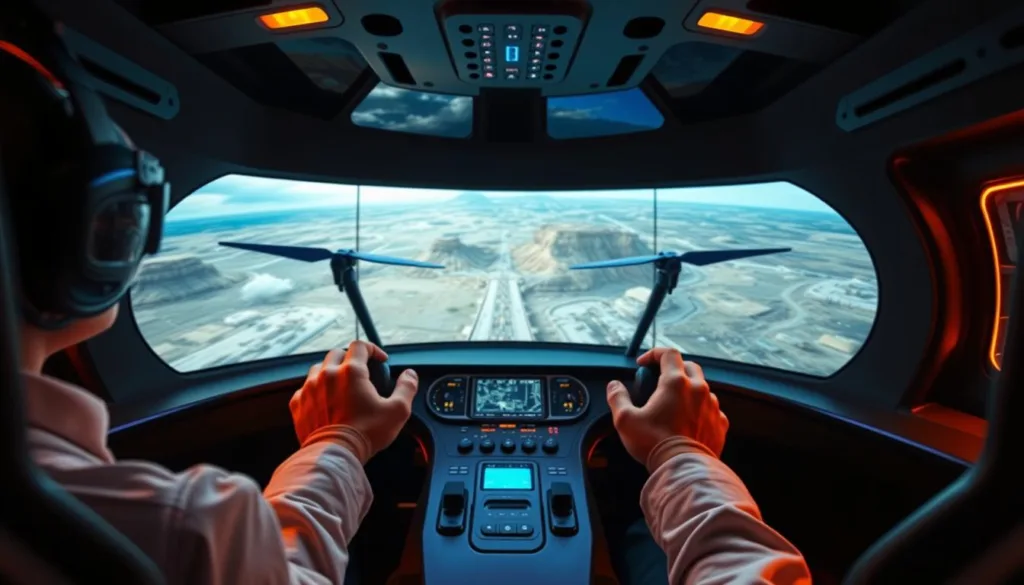


One Response